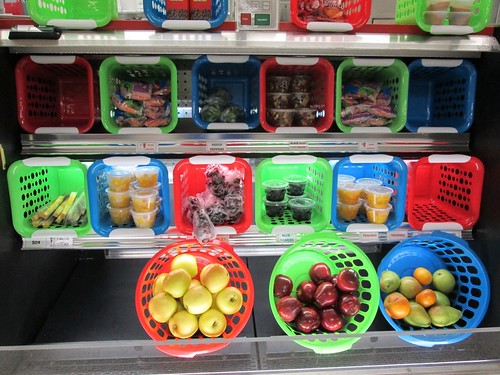
Teenagers at several schools across the country are working together with school nutrition staff to make changes to the school cafeteria. Informed by Smarter Lunchrooms’ research, these students are promoting healthful foods to their peers and having a say in menu offerings. Team Nutrition Training Grants help fund a number of school activities that engage students in nutrition education and wellness activities. To learn more about Team Nutrition Training Grant activities, visit http://www.fns.usda.gov/tn/team-nutrition-training-grants.
The following guest blog describes how Iowa high school students worked with school nutrition staff to alter the way fruits and vegetables are offered in their school cafeteria. Following the changes, other students have taken notice of the new colorful displays, creative menu names, and signs promoting the salad bars. Reading their story, you’ll learn about innovative ways to engage youth in school wellness efforts.
By Carrie Scheidel, MPH, Team Nutrition Co-Director, Iowa Department of Education
As teachers prepared their classrooms for the new school year, school nutrition professionals and students in Iowa were working to make their lunchrooms smarter. A partnership between the University of Iowa Public Policy Center – College of Public Health, Iowa Department of Education, and five Iowa high schools worked to apply Smarter Lunchrooms’ techniques to make healthy choices easier at school.
Smarter Lunchrooms’ techniques apply simple and low-cost changes to school cafeterias based upon principles developed by the Cornell Center for Behavioral Economics in Child Nutrition Programs (BEN). Often times, a few low or no cost changes can make a difference in what students eat and how they feel about their school lunch choices. The key ingredient in Iowa’s Smarter Lunchrooms’ efforts: student participation.
“The Smarter Lunchroom movement has been implemented across the country, but we are enhancing the process by bringing students in from the start,” says Natoshia Askelson, assistant professor and project lead at the College of Public Health.
After meeting with each school individually to train teachers, school nutrition directors and students on Smarter Lunchrooms’ techniques, researchers from the College of Public Health prompted students and school staff to complete a Smarter Lunchrooms self-assessment. Students answered questions about how well their cafeteria focused on fruit, promoted vegetables and salads, and displayed low-fat, unflavored milk, and then photographed what they observed. The students then worked with the school nutrition director to make changes based upon their self-assessment findings. Students at the participating schools soon started noticing the changes made in their lunchrooms, such as newly named menu items, posters and murals, and more vegetable and fruit offerings.
After the changes were made, students in the participating high schools had more favorable perceptions about the foods served at school meals. Students involved in the Smarter Lunchrooms assessments demonstrated an increased understanding of the opportunities and constraints facing school nutrition staff in offering healthy school meals. School nutrition directors also reported gaining insight into the types of foods that appeal to students and what students want in a lunchroom designed to promote healthy choices. Askelson says, “We want students to walk into a lunchroom where the healthy choice is the fun and easy choice, not the choice they have to think about.”
The schools that were part of the project are excited to maintain the changes and look to make more throughout the new school year. The University of Iowa has developed an infographic highlighting student and food service experience and perceptions, identified changes and most common lunchroom additions, and created a student survey for other schools interested in implementing Smarter Lunchroom practices.


